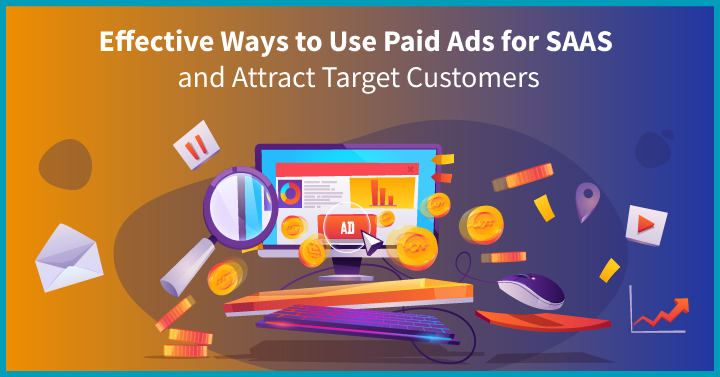Paid ads for SaaS are a great way to give your business a boost and in turn, creating improved interactions with your target client base. They can also be expensive, so rather than going in with a trial-and-error approach, it’s preferable to have a fully considered strategy before you start spending.
This article explains 10 ways to optimize your paid advertising plan to achieve maximum results while still keeping a handle on costs.
1. What Is a Paid Advertising Model?
A paid advertising model is a general term for any approach that involves splashing out for ads, as opposed to earned advertising (such as media coverage) or owned advertising (such as content posts).
One of the most heavily utilized forms of paid advertising model, for example, is pay per click (PPC), where your fee is based upon how many people click on a link to your website.
2. Benefits of Paid Ads for SaaS Businesses
While in the long term, content marketing might be a more cost-effective, sustainable solution, paid ads to provide an immediate boost for lead generation. They are also a more targeted method for how you advertise a SaaS platform, ensuring that people who see your materials fit your ideal demographics. You can even get more specific by using list targeting to go after particular companies and individuals. If someone comes to your site but doesn’t end up converting, you can also retarget them to prompt them to come back to your product at a later date.
3. Types of Paid Ads for B2B SaaS
There are four common types of paid advertising you can use to engage and convert potential customers, which vary by the expense and the kinds of targeting available. Google Ads, Facebook Ads, and LinkedIn Ads all allow you to set a monthly budget cap, so you don’t find yourself unexpectedly spending more than you bargained for. Additionally, they all come with detailed dashboards for you to analyze statistics on key metrics like clickthrough rates and conversions.
- Google Ads
One of the most popular channels for how to grow SaaS sales, Google Ads is a PPC service that can be customized to drive qualified traffic toward your product. The principal channel is Google Search, where you can pay to appear on search engine results pages (SERPs) that are relevant to your software. Depending on the model you select, you can also achieve lead generation through the Google Display Network (ads appear on websites or apps your customer’s visit) or through video campaigns through YouTube.
- Facebook/Insta Ads
Enter the Meta-verse and you can put your company in front of Facebook and Instagram users. The ads interface allows you to select an objective such as lead generation or conversions, then specify an audience by location, behavior, and/or interests, and opt whether to target Facebook feeds, Instagram feeds, Messenger inboxes, or all three. PPC ads can be displayed in six different formats – all designed to work across any device, regardless of connection speed.
- LinkedIn Ads
Considering it’s the world’s largest online professional network, it’s hardly surprising that LinkedIn’s ads service offers the most robust ability to target customers based on company type and job description. While it does offer PPC and pay-per-impression options, LinkedIn also provides the capability to send conversation ads directly to relevant inboxes as well as create sponsored content that appears in feeds.
- Paid Article Listings
Also called content discovery, paid articles listings to allow you to feature native content from your site on other people’s pages via widgets. These widgets are supplied by companies like Taboola and Outbrain. As with the other options listed here, most contents discovery companies charge on a CPC (cost per click) or CPM (cost per mille) basis, with the ability to reach people based on topics, retargeting, and lookalikes (i.e., individuals who match your existing customer profiles).
4. How Can I Promote My SaaS Product?
There are two main routes to promoting SaaS: through SEO-optimized content and through paid ads. Rather than opting for one or the other, the best strategies will combine a mixture of the two. Generating leads and subsequent conversions are usually cheaper through SEO, but paid ads to give you a more immediately tangible boost – which can come in handy if you have a shorter-term campaign focused on a specific metric. A general rule of thumb is that paid advertising costs more but yields more rapid results, whereas keyword-enabled, SEO-optimised content is cheaper and grows your presence exponentially but takes longer to gather mass.
5. Do Paid Ads Work for B2B?
Paid ads can be much more targeted than SEO marketing, which is why an estimated 144.8 billion was spent globally on PPCs last year. You’re also guaranteed to reach a lot more users than you would organically in a shorter period of time. The Google Display Network, for instance, encompasses a whopping 90% of all internet users worldwide. Admittedly, CTRs from paid ads are a fraction of what they are for organic results, but it can be a good strategy while you spend time gradually building up your SEO.
6. 10 Tips to Scale Up Paid Ads for SaaS
6.1 Invest in Brand Ads
Brand advertising builds a concrete niche for your SaaS product, encouraging customers to associate particular keywords and/or concepts with your company.
In general, this will not translate into directly trackable conversions. However, it will help to build a positive, recognizable identity for your service, with clear messaging that informs individuals exactly how your software can help make their working lives easier and more efficient. For example, project management software Monday’s 2018 campaign emphasized its simplicity alongside various use cases through a colorful multichannel approach.
6.2 Start with Leveraging One or Two Channels
It’s very easy to get over-excited about utilizing paid ads for SaaS in a grand vision of omnichannel marketing. Realistically, however, it’s just going to be a resource-devouring muddle of ideas, with too much data to analyze and digest.
Instead, start by leveraging just one or two channels, whether that’s Google Ads or LinkedIn. Which one will most effectively help you engage more of your target audience? How much money do you have to spend and what’s the estimated ROI for that budgetary bracket? It’s worth bearing in mind that some paid ads solutions require a more initial investment to move the needle than others. Take a look at this comparison, which shows LinkedIn entails much greater costs than Facebook.
6.3 Build a Sales Funnel
Take customers on a smooth journey from search to sale. At the top of the funnel, your paid ads for SaaS should attract people who are investigating solutions to a problem, say, by bidding for certain keywords on SERPs. Next, move the individual down through the middle of the funnel by explaining your value proposition, e.g., with demos and trials. From there, sales teams can take up pre-qualified leads.
Formulating the most effective customer journey will take some tweaking, but you can use analytics programs to see where individuals drop off along the way to improve your sales funnel as you go. Here, you can see several examples of how SaaS businesses have constructed their websites to make the most of click-throughs, complete with product proposition, additional resources like webinars, and staggered pricing plans that detail various levels of offering.
6.4 Invest in Google Paid Search
Google is by far the world’s most used search engine, which is what makes it such an attractive platform when it comes to paid advertising. Using its Keyword Planner, you can analyze search volumes and estimated cost per click, before committing to a concrete plan of attack.
It’s easy and quick to get up and running, with the ability to continuously monitor success and tweak targets and terms as needed. What does take time is: a) the prior research necessary to reach your customer base; b) creating optimized landing pages, which reduce CPC and increase the chance of a conversion.
If done well, however, Google Ads can lead to huge growth in relevant leads, as demonstrated by nutritional software NutriCalc, which increased their clickthrough rate by 125%.
6.5 Use Retargeting Methods
Facebook, LinkedIn, and Google all offer retargeting capabilities, allowing you to put your product in front of people who have already been on your site. This is done through placing tracking pixels, which collect the data of visitors.
On the one hand, retargeting is a great way to continue a user journey by building upon what they have already seen of your business. On the other hand, finding the right balance between stimulating interest and annoying people with your repeated presence on their screen is a tricky tightrope to tread. Accounting software Sage was able to craft a successful method to retarget HR and payroll staff with paid ads by promoting purchases following downloads of a free compliance guide.
6.6 Leverage Your Social Media Accounts
Popular social media outlets like Facebook, Twitter, TikTok, and Instagram all offer paid ads solutions that can be utilized to attract leads in custom demographics, depending on what product strategy in SaaS you decide to use.
Paid ads on social media tend to blend into feeds more seamlessly than elsewhere and have better engagement rates but bear in mind that people on services like Instagram and TikTok probably aren’t there with the intention of working or purchasing a SaaS product. Having said that, marketing and sales platform Drift used Facebook to present a visual, stat-forward case study to drive leads, highlighting a happy customer in its sponsored post.
6.7 Create Short Video Ads
Don’t forget to include video ads when compiling a strategy for your B2B SaaS marketing channels, as these can utilize targeting in many of the same ways as keywords.
While text and image ads are easier to create, video ads typically have increased engagement and can disseminate more information. However, they can also usually be skipped after a few seconds. Highlighting the importance of video, a 2021 survey by Wyzowl found that 86% of marketers use video as a marketing tool, while 79% of non-video marketers expected to start this year thanks to the increasing ease and affordability of doing it themselves.
6.8 Start LinkedIn Advertising
In addition to LinkedIn’s PPC and sponsored ads, the professional network also has a service called Lead Gen Forms. If you have white papers, webinars, or other desirable content to share, you can opt to make it available only after individuals have submitted a form that is pre-filled from their LinkedIn profile.
This approach allows for more quality leads, which can also be pre-screened by role and company, depending on your target market. LinkedIn estimates that the average conversion rate from Lead Gen Forms is 13% higher than the 2.35% of landing pages. First, though, you’ll need to have an attractive piece of content in the can. In a test of the feature’s utility, B2B marketing agency Ledger Bennett found it led to a 147% higher conversion rate than landing pages, resulting in a 59% lower cost per lead.
6.9 Bid on Competitor Names
One tactic to try and build awareness for your SaaS product is to place keyword bids on competitor names. This will lead people searching for a better-known solution in your field to encounter your solution as well.
While the downside is that any person searching for a competitor is probably already predisposed to that brand, it gives you the opportunity to present your alternative offering in a positive light, emphasizing where you are strongest and have an advantage. There’s also the bonus that competitor names tend to be cheaper keywords, as fewer people are bidding on something so specific.
6.10 Target with Different Content Variations
Mixing content types is another way you can improve the effectiveness of your paid ads for SaaS. If possible, include a mixture of text, image, and video content, as well as potentially webinars and white papers, to attract clicks.
Different individuals consume information differently, so there’s an obvious benefit to creating different routes to sales conversions – provided you have the resources, of course.
7. Examples of Paid Ads for SaaS
7.1 Incapsula
Cyber security provider Incapsula were able to scale up its paid ads strategy by, first of all, restructuring its Google paid search strategy, picking up niche and long-tail keywords that were being minimally serviced. They then expanded their scope into the Google Display Ad Network and LinkedIn, utilizing previous content assets to save costs. The result was a 610% increase in marketing qualified leads (MQLs) and a 1012% increase in the number of conversions.
7.2 Dooly
Dooly was created to simplify sales processes and customer relationship management. The company used different content formats in their paid ads on LinkedIn to capture people at different stages of the sales funnel, mixing brand awareness assets with those designed to facilitate the purchasing stages.
8. FAQ
8.1 How Is SaaS Marketing Different?
SaaS marketing tends to focus on B2B, which is a very different kettle of fish to consumer dynamics. Additionally, SaaS as a product is by definition not a tangible acquisition, so there is a different psychological methodology at play compared to concrete products like a computer or an office space.
8.2 What Is a Paid Ad Strategy?
The strategy behind paid ads for SaaS should always be about driving conversions, whether through keyword bidding on Google, video snippets on YouTube, or PPC links via LinkedIn.
About Us
Growth Ganik is a rapidly evolving digital marketing agency in Sydney, Australia that specializes in SEO, content marketing, marketing strategy and lead generation.
We work with clients from leading brands and industries such as B2B SaaS, nonprofits and more to develop profitable digital marketing solutions that are data-driven to support all kinds of business goals from widening user bases, gaining more traction for online engagement, to increasing conversion and helping businesses scale up.
For creative tailor-made digital solutions and sustainable growth insights, get in touch with us!











